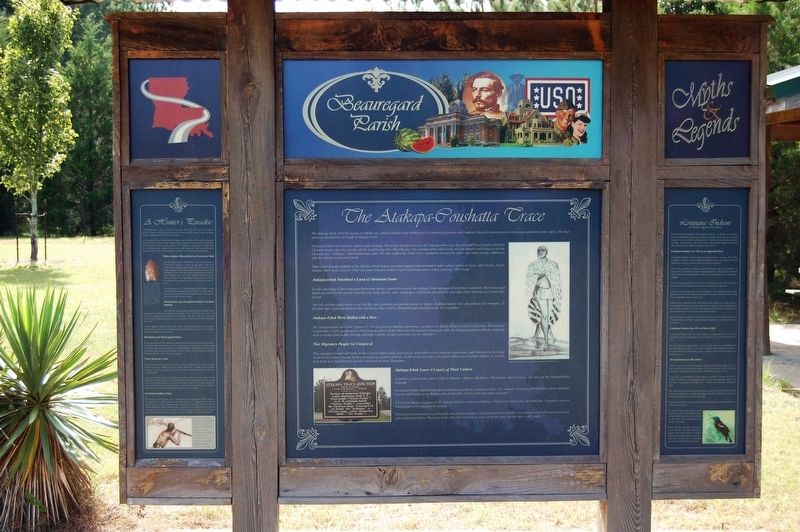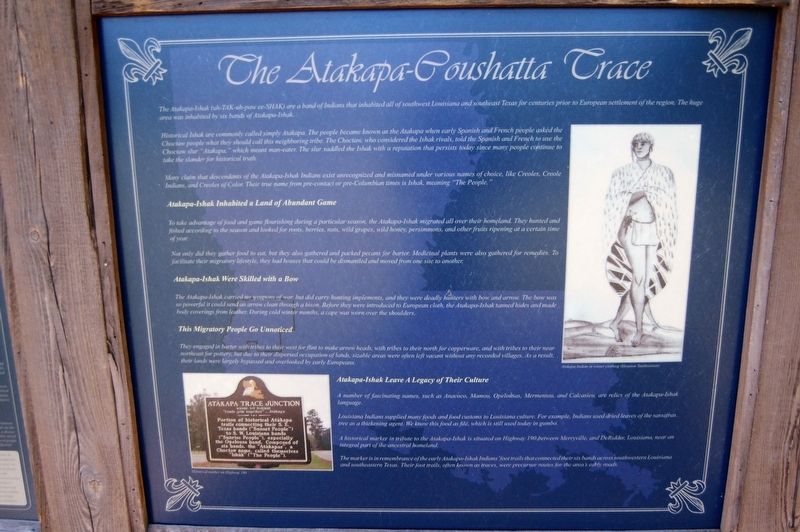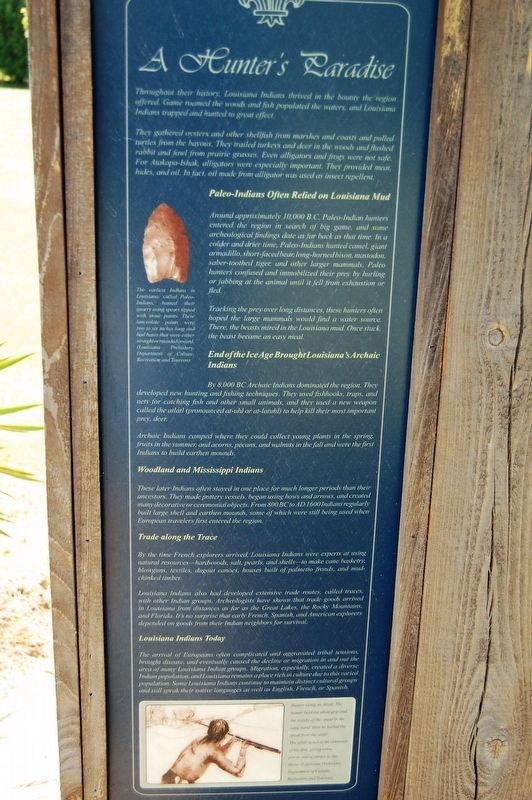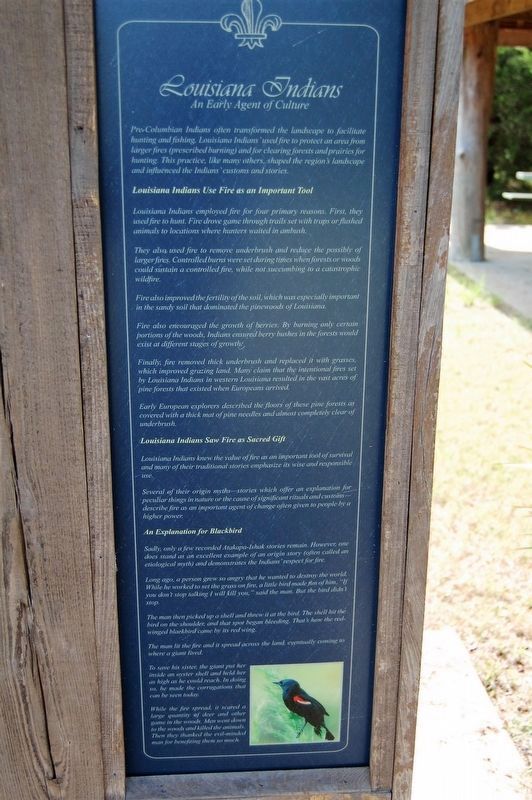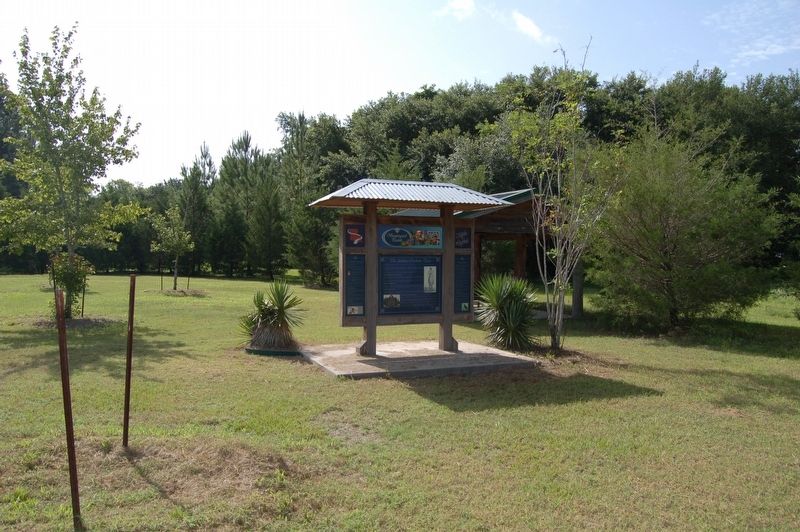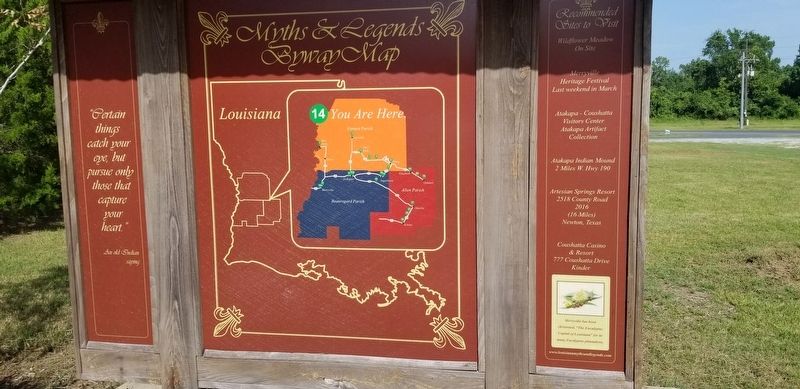Merryville in Beauregard Parish, Louisiana — The American South (West South Central)
The Atakapa-Coushatta Trace
Myths and Legends - Beauregard Parish
The Atakapa-Ishak (uh-TAK-uh-paw ee-SHAK) are a band of Indians that inhabited all of southwest Louisiana and southeast Texas for centuries prior to European settlement of the region. The huge area was inhabited by six bands of Atakapa-Ishak.
Historical Ishak are commonly called simply Atakapa. The people became known as the Atakapa when early Spanish and French people asked the Choctaw people what they should call this neighboring tribe. The Choctaw, who considered the Ishak rivals, told the Spanish and French to use the Choctaw, slur "Atakapa,” which meant man-eater. The slur saddled the Ishak with a reputation that persists today since many people continue to take the slander for historical truth.
Many claim that descendants of the Atakapa-Ishak Indians exist unrecognized and misnamed under various names of choice, like Creoles, Creole Indians, and Creoles of Color. Their true name from pre-contact or pre-Columbian times is Ishak, meaning "The People."
Atakapa-Ishak Inhabited a Land of Abundant Game
To take advantage of food and game flourishing during a particular season, the Atakapa-Ishak migrated all over their homeland. They hunted and fished according to the season and looked for roots, berries, nuts, wild grapes, wild honey, persimmons, and other fruits ripening at a certain time of year.
Not only did they gather food to eat, but they also gathered and packed pecans for barter. Medicinal plants were also gathered for remedies. To facilitate their migratory lifestyle, they had houses that could be dismantled and moved from one site to another.
Atakapa-Ishak Were Skilled with a Bow
The Atakapa-Ishak carried no weapons of war, but did carry hunting implements, and they were deadly hunters with bow and arrow. The bow was so powerful it could send an arrow clean through a bison. Before they were introduced to European cloth, the Atakapa-Ishak tanned hides and made body coverings from leather. During cold winter months, a cape was worn over the shoulders.
This Migratory People Go Unnoticed
They engaged in barter with tribes to their west for flint to make arrow heads, with tribes to their north for copperware, and with tribes to their near northeast for pottery, but due to their dispersed occupation of lands, sizable areas were often left vacant without any recorded villages. As a result, their lands were largely bypassed and overlooked by early Europeans.
Atakapa-Ishak Leave A Legacy of Their Culture
A number of fascinating names, such as Anacoco, Mamou, Opelousas, Mermentau, and Calcasieu, are relics of the Atakapa-Ishak language.
Louisiana Indians supplied many foods and food customs to Louisiana culture. For example, Indians used dried leaves of the sassafras. tree as a thickening agent. We know this food as filé, which is still used today in gumbo.
A historical marker in tribute to the Atakapa-Ishak is situated on Highway 190 between Merryville, and DeRidder, Louisiana, near an integral part of the ancestral homeland.
The marker is in remembrance of the early Atakapa-Ishak Indians 'foot trails that connected their six bands across southwestern Louisiana and southeastern Texas. Their foot trails, often known as traces, were precursor routes for the area's early roads.
A Hunter's Paradise
Throughout their history, Louisiana Indians thrived in the bounty the region offered. Game roamed the woods and fish populated the waters, and Louisiana Indians trapped and hunted to great effect.
They gathered oysters and other shellfish from marshes and coasts and pulled turtles from the bayous. They trailed turkeys and deer in the woods and flushed rabbit and fowl from prairie grasses. Even alligators and frogs were not safe. For Atakapa-Ishak, alligators were especially important. They provided meat, hides, and oil. In fact, oil made from alligator was used as insect repellent.
Paleo-Indians Often Relied on Louisiana Mud
Around approximately 10,000 B.C. Paleo-Indian hunters entered the region in search of big game, and some archeological findings date as far back as that time. In a colder and drier time, Paleo-Indians hunted camel, giant armadillo, short-faced bear, long-horned bison, mastodon, saber-toothed tiger and other larger mammals. Paleo hunters confused and immobilized their prey by hurling or jabbing at the animal until it fell from exhaustion or fled.
Tracking the prey over long distances, these hunters often hoped the large mammals would find a water source. There, the beasts mired in the Louisiana mud. Once stuck, the beast became an esy meal.
End of the Ice Age Brought Louisiana's Archaic Indians
By 8,000 BC Archaic Indians dominated the region. They developed new hunting and fishing techniques. They used fishhooks, traps, and nets for catching fish and other small animals, and they used a new weapon called the atlatl (pronounced at-uhl or at-latuhl) to help kill their most important prey, deer. Archaic Indians camped where they could collect young plants in the spring, fruits in the summer, and acorns, pecans, and walnuts in the fall and were the first Indians to build earthen mounds.
Woodland and Mississippi Indians
These later Indians often stayed in one place for much longer periods than their ancestors. They made pottery vessels, began using bows and arrows, and created many decorative or ceremonial objects. From 800 BC to AD 1600 Indians regularly built large shell and earthen mounds, some of which were still being used when European travelers first entered the region.
Trade along the Trace
By the time French explorers arrived, Louisiana Indians were experts at using natural resources-hardwoods, salt, pearls, and shells-to make cane basketry, blowguns, textiles, dugout canoes, houses built of palmetto fronds, and mud- chinked timber
Louisiana Indians also had developed extensive trade routes, called traces, with other Indian groups. Archeologists have shown that trade goods arrived in Louisiana from distances as far as the Great Lakes, the Rocky Mountains. and Florida. It's no surprise that early French, Spanish, and American explorers depended on goods from their Indian neighbors for survival.
Louisiana Indians Today
The arrival of Europeans often complicated and aggravated tribal tensions, brought disease, and eventually caused the decline or migration in and out the area of many Louisiana Indian groups. Migration, especially, created a diverse Indian population, and Louisiana remains a place rich in culture due to this varied population. Some Louisiana Indians continue to maintain distinct cultural groups and still speak their native languages as well as English, French, or Spanish.
Louisiana Indians
An Early Agent of Culture
Pre-Columbian Indians often transformed the landscape to facilitate hunting and fishing. Louisiana Indians 'used fire to protect an area from larger fires (prescribed burning) and for clearing forests and prairies for hunting. This practice, like many others, shaped the region's landscape and influenced the Indians' customs and stories.
Louisiana Indians Use Fire as an Important Tool
Louisiana Indians employed fire for four primary reasons. First, they used fire to hunt. Fire drove game through trails set with traps or flushed animals to locations where hunters waited in ambush.
They also used fire to remove underbrush and reduce the possibly of larger fires. Controlled burns were set during times when forests or woods could sustain a controlled fire, while not succumbing to a catastrophic. wildfire.
Fire also improved the fertility of the soil, which was especially important in the sandy soil that dominated the pinewoods of Louisiana.
Fire also encouraged the growth of berries. By burning only certain portions of the woods, Indians ensured berry bushes in the forests would exist at different stages of growth.
Finally, fire removed thick underbrush and replaced it with grasses, which improved grazing land. Many claim that the intentional fires set by Louisiana Indians in western Louisiana resulted in the vast acres of pine forests that existed when Europeans arrived.
Early European explorers described the floors of these pine forests as covered with a thick mat of pine needles and almost completely clear of underbrush.
Louisiana Indians Saw Fire as Sacred Gift
Louisiana Indians knew the value of fire as an important tool of survival and many of their traditional stories emphasize its wise and responsible use.
Several of their origin myths-stories which offer an explanation for peculiar things in nature of the cause of significant rituals and customs- describe fire as an important agent of change often given to people by a higher power.
An Explanation for Blackbird
Sadly, only a few recorded Atakapa-Ishak stories remain. However, one does stand as an excellent example of an origin story (often called an etiological myth) and demonstrates the Indians respect for fire.
Long ago, a person grew so angry that he wanted to destroy the world. While he worked to set the grass on fire, a little bird made fun of him. "If you don't stop talking I will kill you," said the man. But the bird didn't stop.
The man then picked up a shell and threw it at the bird. The shell hit the bird on the shoulder, and that spot began bleeding. That's how the red- winged blackbird came by its red wing.
The man lit the fire and it spread across the land, eventually coming to where a giant lived.
To save his sister the giant put her inside an oyster shell and held her as high as he could reach. In doing so, he made the corrugations that can be seen today.
While the fire spread, it scared a large quantity of deer and other game in the woods. Men went down to the woods and killed the animals. Then they thanked the evil-minded man for benefiting them so much.
Erected by Louisiana Myths and Legends Byways.
Topics and series. This historical marker is listed in these topic lists: Native Americans • Roads & Vehicles. In addition, it is included in the Louisiana Myths & Legends Byway series list.
Location. 30° 45.509′ N, 93° 32.734′ W. Marker is in Merryville, Louisiana, in Beauregard Parish. Marker is at the intersection of North Bryan Street and U.S. 190 on North Bryan Street. Touch for map. Marker is at or near this postal address: 703 N Bryan Street, Merryville LA 70653, United States of America. Touch for directions.
Other nearby markers. At least 8 other markers are within 7 miles of this marker, measured as the crow flies. Site of the Coushatta Indian Village (within shouting distance of this marker); Charles "Leather Bitches" Smith (approx. 0.3 miles away); Burk's Log Cabin (approx. 0.4 miles away); Sam Houston Jones (approx. 0.4 miles away); Leather Britches (approx. 0.4 miles away); Inman Cemetery (approx. 5˝ miles away in Texas); Atákapa Trace Junction (approx. 5.7 miles away); Bon Wier (approx. 6.2 miles away in Texas). Touch for a list and map of all markers in Merryville.
More about this marker. Located on the grounds of The Atakapa-Coushatta Trace Visitors center.
Credits. This page was last revised on November 23, 2022. It was originally submitted on November 22, 2022, by Cajun Scrambler of Assumption, Louisiana. This page has been viewed 564 times since then and 152 times this year. Photos: 1. submitted on November 22, 2022, by Cajun Scrambler of Assumption, Louisiana. 2, 3, 4, 5, 6. submitted on November 23, 2022, by Cajun Scrambler of Assumption, Louisiana.
